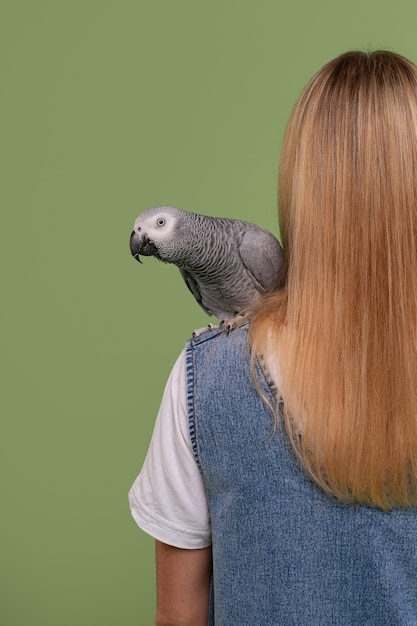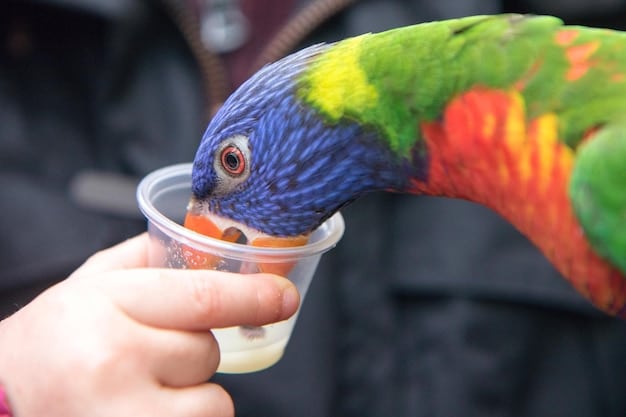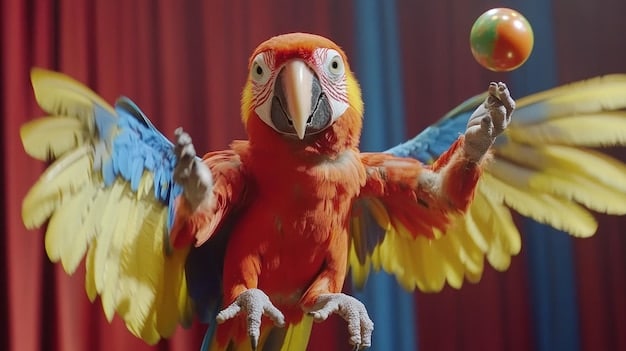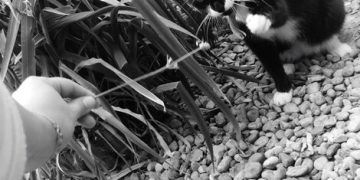Train Your Parrot: Positive Reinforcement for Optimal Results

Training your parrot using positive reinforcement involves rewarding desired behaviors with treats, praise, or toys, creating a positive association and encouraging repetition for optimal results.
Ready to unlock the potential of your feathered friend? Discover how to train your parrot: positive reinforcement techniques for optimal results, that creates a harmonious and enriching relationship.
Understanding Positive Reinforcement for Parrot Training
Positive reinforcement is a cornerstone of effective parrot training. It focuses on rewarding desired behaviors to encourage their repetition, creating a positive association between the parrot’s actions and the positive outcome.
This method is not only humane but also incredibly effective in building trust and strengthening the bond between you and your parrot. By understanding the principles of positive reinforcement, you can create a stimulating and rewarding training environment for your feathered companion.
Why Positive Reinforcement Works
Positive reinforcement works because it taps into the parrot’s natural instincts and desires. Parrots are intelligent creatures that respond well to positive interactions and rewards.
Benefits of Positive Reinforcement
Choosing positive reinforcement as your training method brings various advantages for your parrot.
- Enhances the Bond: Positive interactions strengthen the bond between you and your parrot.
- Encourages Cooperation: Parrots are more likely to cooperate when they associate training with positive outcomes.
- Reduces Stress: Positive reinforcement eliminates the fear and stress associated with punishment-based methods.
- Promotes Learning: Rewarding desired behaviors encourages parrots to learn and repeat those behaviors.
In conclusion, understanding and practicing positive reinforcement is crucial for developing an efficient and caring training approach. The method utilizes your parrot’s natural tendencies, establishing a cooperative connection based on trust and mutual respect. This understanding not only benefits their learning process but also significantly improves the relationship you share.

Choosing the Right Rewards for Your Parrot
Selecting the right rewards is a critical step in effective positive reinforcement training. The reward should be something your parrot genuinely values and finds motivating.
Experiment with different options to discover what works best for your individual bird. Consider factors like your parrot’s preferences, nutritional needs, and the intensity of the training session when selecting rewards.
Types of Rewards
Selecting the right type of reward is critical to maintain your parrot engaged and motivated during training.
Tips for Selecting Rewards
Considering a number of key factors will help you effectively choose rewards that promote maximum levels of training success.
- Consider Preferences: Take note of your parrot’s favored foods, treats, and toys.
- Vary Rewards: Keep training sessions interesting by rotating rewards.
- Use High-Value Rewards: Reserve highly valued rewards for more challenging behaviors or milestones.
- Offer Praise: Combine verbal praise with tangible rewards to reinforce positive behavior.
In summary, choosing the right incentives is essential to successfully train your parrot using positive reinforcement. By thoughtfully picking incentives that appeal to your parrot, keeping variety, and combining appreciation with visible benefits, you may create a fun training environment that solidifies the connection with your pet while encouraging desired actions.
Implementing Positive Reinforcement Techniques
Implementing positive reinforcement techniques requires consistency, patience, and a clear understanding of the desired behaviors. Establishing clear goals and expectations will help you train your parrot effectively.
Consistency is key, so be sure to reinforce desired behaviors every time they occur. With patience and persistence, you can successfully shape your parrot’s behavior and build a strong bond based on trust and mutual respect.
Setting Clear Goals
Start by identifying the specific behaviors you want to teach your parrot. Break down complex behaviors into smaller, manageable steps.
Shaping Behavior
Shaping behavior involves reinforcing successive approximations of the desired behavior. Start by rewarding any behavior that resembles the target behavior and gradually increase the criteria for reinforcement.
- Start Simple: Begin with easy behaviors that your parrot can easily perform.
- Reward Progress: Reinforce small steps towards the desired behavior.
- Be Patient: Shaping behavior takes time and patience, so don’t get discouraged.
- Avoid Punishment: Focus on rewarding desired behaviors rather than punishing unwanted ones.
To summarize, implementing positive reinforcement through well-defined objectives and constant encouragement is important for great success in training your parrot. By methodically reinforcing each little enhancement and keeping consistent, you may effectively help your parrot develop new abilities. This strategy not only helps in training but also promotes a loving and respectful atmosphere, which enhances the relationship you have with your feathery friend.

Troubleshooting Common Training Challenges
Even with the best intentions, you may encounter challenges during the training process. Understanding how to troubleshoot common issues can help you stay on track and achieve your training goals.
Remember that every parrot is unique, and some may require more patience and understanding than others. By staying flexible and adapting your approach, you can overcome obstacles and create a positive training experience for both you and your parrot.
Lack of Motivation
If your parrot seems uninterested in training, it may be due to a lack of motivation. Assess the rewards you’re using and consider whether they are truly valuable to your bird.
Inconsistent Performance
Inconsistent performance can be frustrating, but it’s important to remain patient and understanding. Ensure that you are providing clear and consistent cues and that your parrot is not experiencing any underlying stress or anxiety.
- Review Cues: Make sure your cues are clear and consistent.
- Adjust Environment: Minimize distractions and create a calm training environment.
- Consult an Expert: Seek guidance from a certified avian behavior consultant if needed.
- Stay Positive: Maintain a positive attitude and celebrate small victories.
In conclusion, anticipating and successfully handling typical problems throughout your parrot’s positive reinforcement training is essential for keeping things on track. When you see problems such a lack of desire or conflicting actions, reviewing your methods and modifying the surroundings may make training sessions more fruitful. Furthermore, encouraging perseverance and celebrating even minor achievements guarantees that you and your parrot have a satisfying and loving training environment, therefore reinforcing the link between you.
Advanced Positive Reinforcement Techniques
Once your parrot has mastered basic behaviors, you can explore more advanced positive reinforcement techniques to expand their repertoire and enhance their cognitive abilities.
These techniques require patience, creativity, and a willingness to experiment. By pushing the boundaries of your parrot’s learning potential, you can unlock new levels of interaction and enjoyment.
Target Training
Target training involves teaching your parrot to touch a specific object with its beak or foot. This technique can be used to guide your parrot’s movements and teach complex behaviors.
Clicker Training
Clicker training uses a distinct sound (usually a clicker) to mark the exact moment a desired behavior occurs. This precise timing can help your parrot learn more quickly and efficiently.
- Associate the Clicker: Pair the clicker sound with a reward to create a positive association.
- Click and Reward: Click the clicker immediately after the desired behavior occurs, followed by a reward.
- Shape Complex Behaviors: Use the clicker to mark successive approximations of the target behavior.
- Fade the Clicker: Once the behavior is well-established, you can gradually fade the use of the clicker.
In summary, using sophisticated positive reinforcement methods to broaden your parrot’s talents and enhance their cognitive growth may be very beneficial after they’ve learned core behaviors. Methods like target training and using a clicker help educate your parrot, but they also promote cognitive and motor skills. These sophisticated strategies improve your training attempts by inspiring creativity and creating a lively learning atmosphere for everyone.
Maintaining Consistency and Patience
Consistency and patience are essential throughout the positive reinforcement training process. Parrots thrive on routine and predictability, so it’s important to establish a consistent training schedule.
Likewise, maintaining patience and understanding is vital, especially when your parrot is struggling to learn a new behavior. Remember that progress takes time, and setbacks are a normal part of the learning process.
Creating a Training Schedule
Set aside dedicated time each day for training sessions. Keep sessions short and engaging to maintain your parrot’s interest.
Staying Positive
Maintaining a positive attitude is crucial for success. Celebrate small victories and focus on progress, not perfection.
- Celebrate Successes: Acknowledge and celebrate every milestone, no matter how small.
- Stay Optimistic: Believe in your parrot’s ability to learn and grow.
- Be Forgiving: Don’t dwell on mistakes or setbacks; simply redirect and try again.
- Enjoy the Journey: Appreciate the opportunity to bond with your parrot and witness their progress.
Finally, remember that effort and persistence are essential for proper reinforcement training when teaching your parrot. You may create a caring and motivating environment for the feathery pal by setting regular times and being patient, which will improve the bond between you. Accept every small accomplishment and keep a good outlook; remember that failures are temporary and training is an ongoing process. You promote an engaging training environment that guarantees not just success but also a more intimate relationship with your parrot by emphasizing endurance and the joy of growth.
| Key Element | Brief Description |
|---|---|
| 🎉 Rewards | Use treats, praise, or toys that motivate your parrot. |
| 🎯 Clear Goals | Set specific, achievable training objectives. |
| 🗓️ Consistency | Train regularly to reinforce learned behaviors. |
| 👍 Patience | Training takes time; remain understanding during the process. |
Frequently Asked Questions
▼
Positive reinforcement involves rewarding desired behaviors to encourage repetition. This creates a positive association, making the parrot more likely to repeat the action.
▼
Select rewards that your parrot genuinely values, such as favorite treats, toys, or verbal praise. Vary the rewards to keep training sessions interesting and engaging.
▼
Aim for short, frequent training sessions (10-15 minutes) several times a day. Consistency is key, but avoid overtraining, which can lead to frustration and disinterest.
▼
Assess the rewards, cues, and training environment. Make sure your parrot is motivated, the cues are clear, and the environment is free from distractions. Seek expert guidance if needed.
▼
The timeline varies depending on the parrot’s individual learning style, the complexity of the behavior, and the consistency of training. Patience and persistence are crucial for long-term success.
Conclusion
Mastering **how to train your parrot: positive reinforcement techniques for optimal results** requires understanding parrot psychology, choosing appropriate incentives, staying consistent, and keeping patience. You may make your connection with your parrot better while improving their actions. Positive reinforcement promotes trust and effective communication between friends, as well as the formation of a harmonic and enjoyable training environment. Remember that with commitment and knowledge, you will be well on your route to having a well-behaved and joyful feathery friend.





